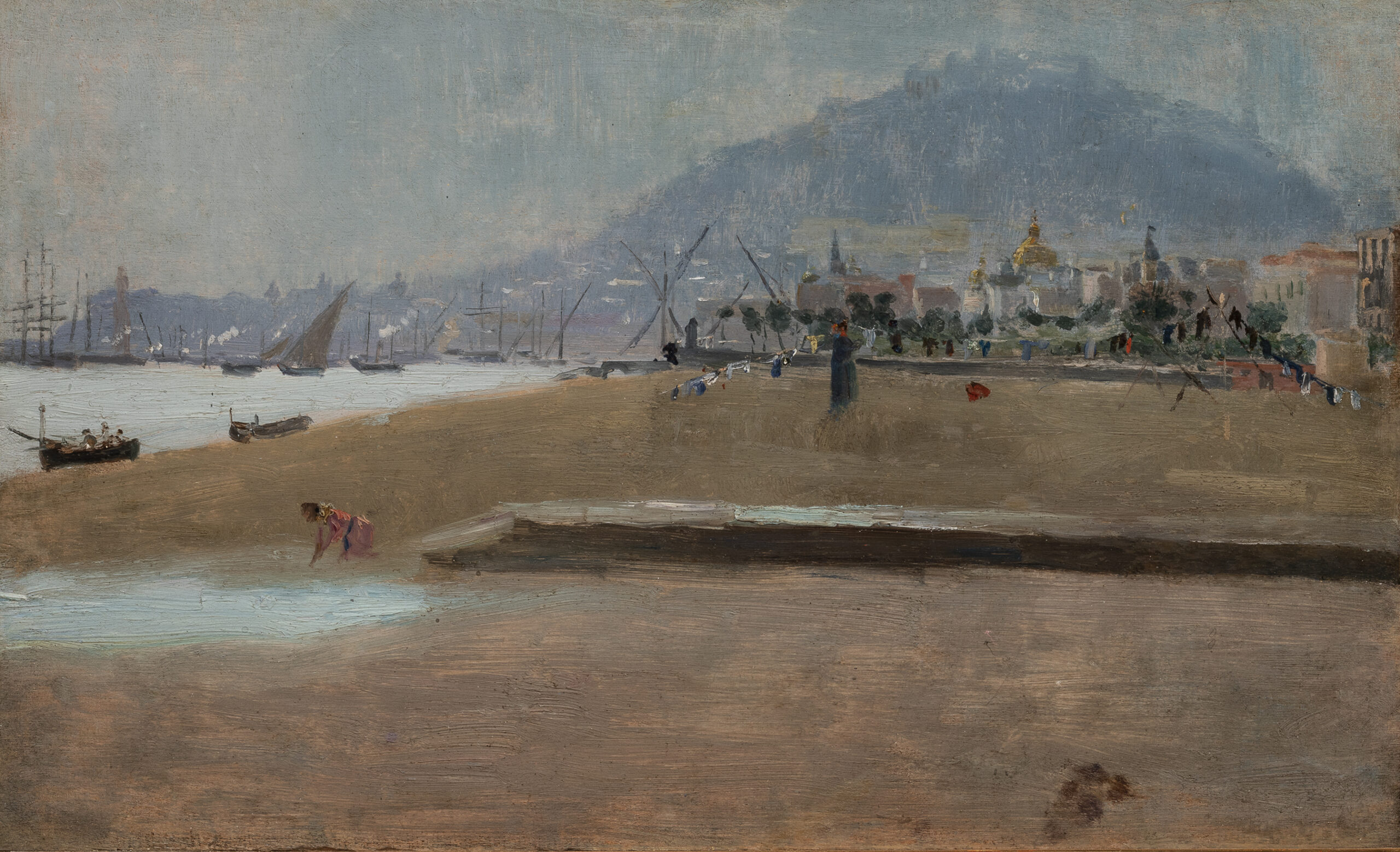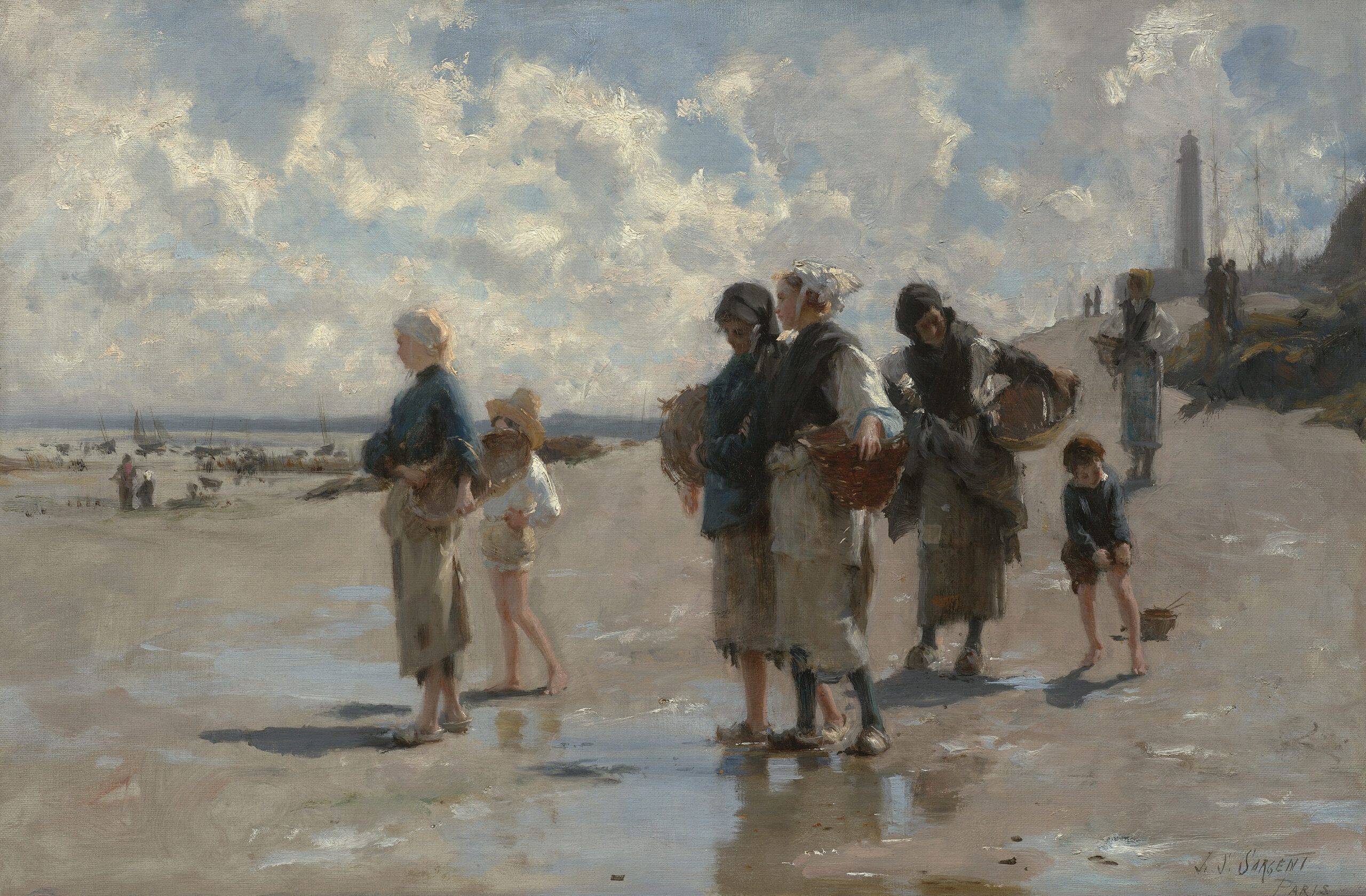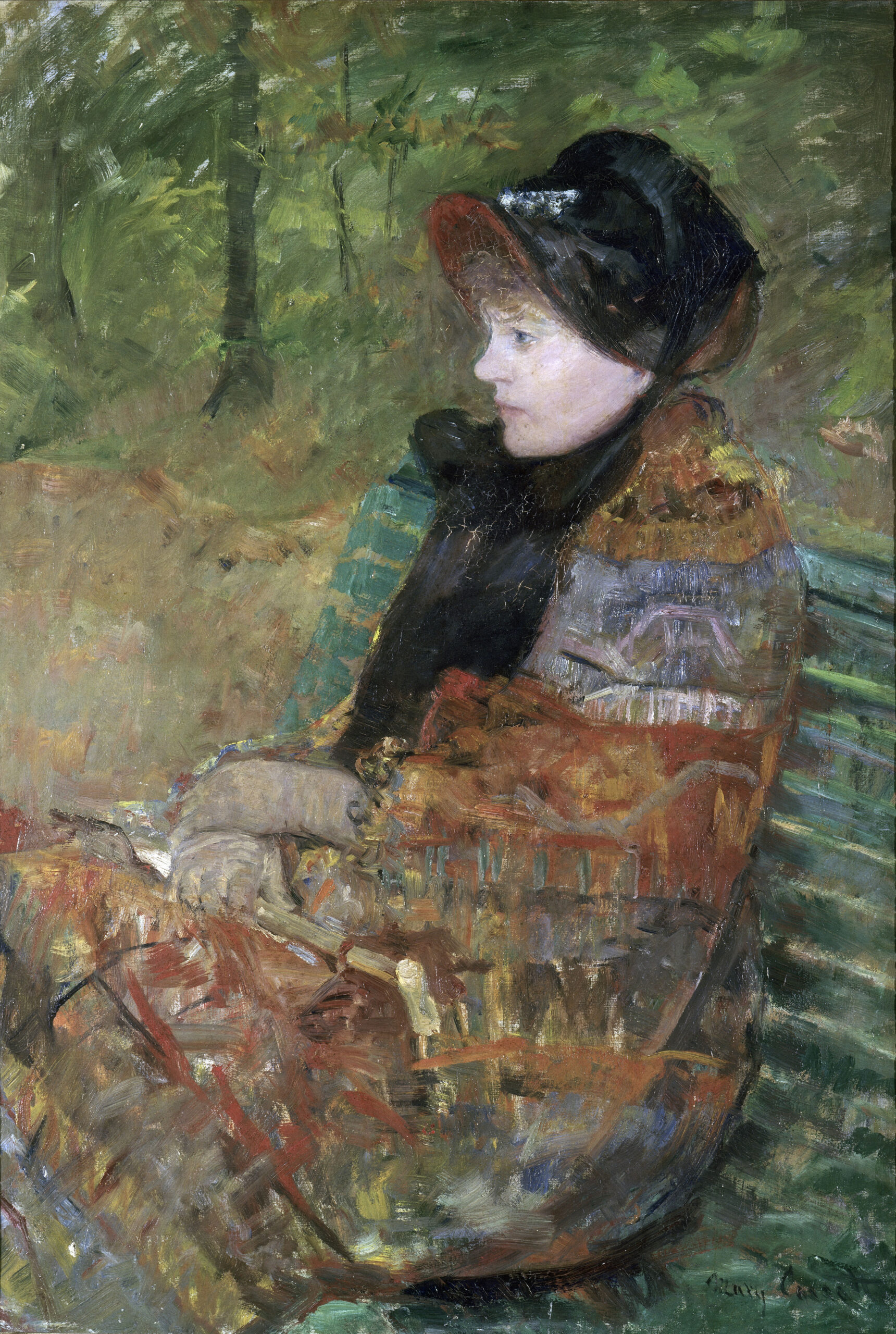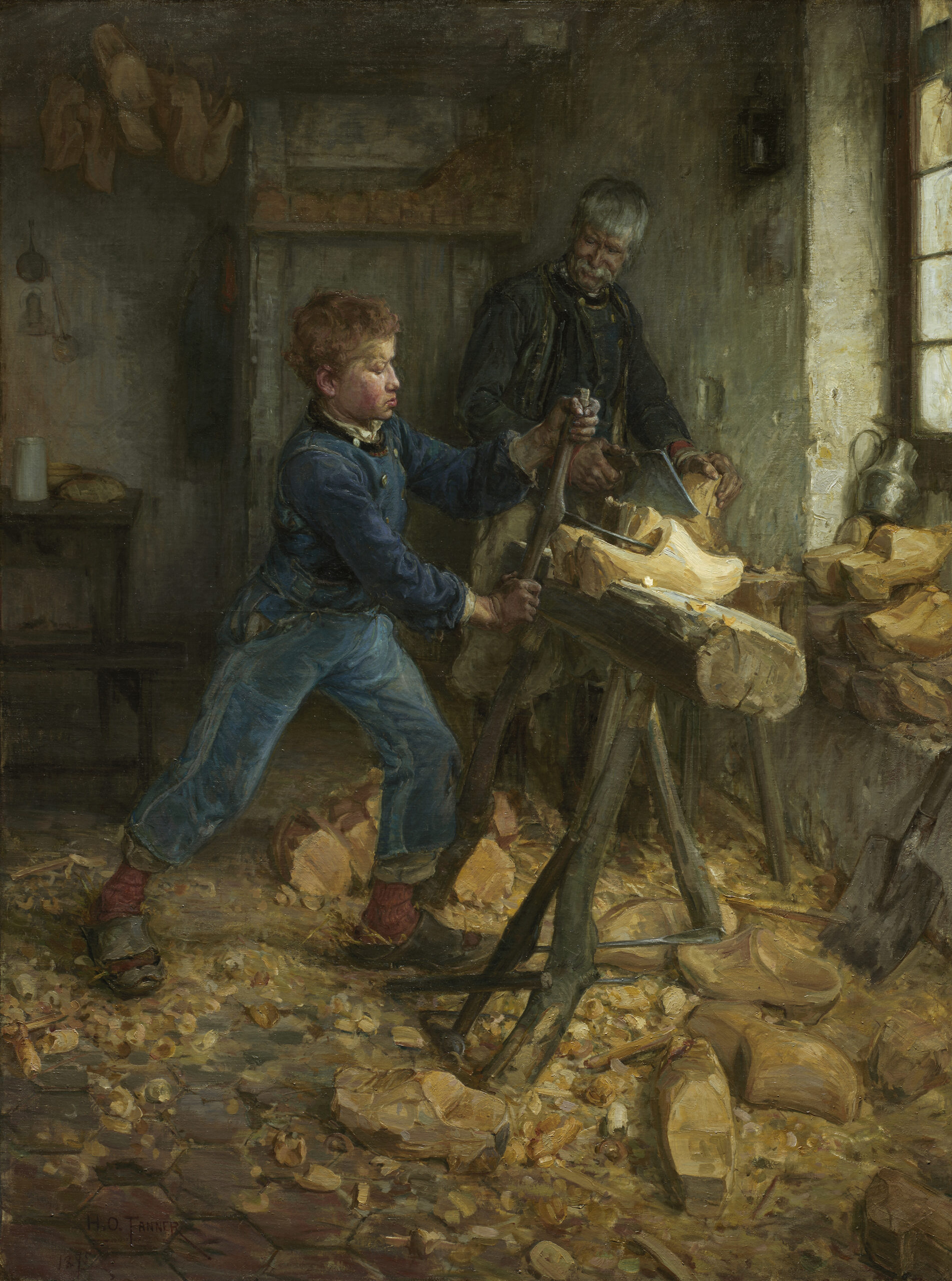
The Beach at Marseille, 1901, James McNeill Whistler (American, 1834–1903), oil on panel. (Terra Foundation for American Art, Chicago)
A promising sign for me that the pandemic is slackening is the number of friends who’ve just returned from, or are soon jetting off to, Italy, St. Barts, Spain or Sweden. But for those staying put like myself, a trip to the Virginia Museum of Fine Arts is a culturally rich, Parisian-like experience.
“Whistler to Cassatt: American Painters in France” is a colorful and nuanced explosion of Gilded Age artworks by such boldface names as Winslow Homer, John Singer Sargent and James McNeill Whistler (you may know his mother) and many artists that may not be familiar. The exhibition continues through July 31.
The first image you see approaching the highly navigable installation is a huge, 1888 photo mural of the Eiffel Tower being constructed for the Paris World’s Fair. Since the image captures the soaring icon only half-built suggests that big changes in engineering were underway in late 19th-century France. Similarly, the visual arts in the western world also underwent a radical transition from 1855 to 1914 — from long-standing strict academic traditions to lighter, brighter Impressionism. The VMFA show poses the question: what part did Americans play in this drama?

Fishing for Oysters at Cancale, 1878, John Singer Sargent (American, 1856–1925), oil on canvas. (Museum of Fine Arts Boston)
The exhibition’s lead organizer was Timothy James Standring, curator emeritus of the Denver Art Museum (which initiated the exhibition). He and his collaborators, including Susan J. Rawles, associate curator of American painting and decorative arts at the VMFA, make the case that American artists who headed to France in the late 1800s often eschewed conservative American realism for looser Impressionism, thereby setting the stage for Modernism. Rawles also lends her scholarly voice to her catalog essay that explores how women painters were savvy in elbowing their way into drawing classes, ateliers, and galleries both in Europe and back home. We learn that women artists assisted other women artists to break glass ceilings and of the storied career of Philadelphian Mary Cassatt. The exhibition also furthers our appreciation for lesser-known American artists like Cecilia Beaux, Elizabeth Jane Gardner, Elizabeth Nourse, and Lila Cabot Perry.
To encapsulate a half century of such vital artistic activity in France in one exhibition is a neat trick. But the 100-plus artworks from leading international museums are arranged in a sequence akin to nine intimate exhibits with a shared narrative. “This Transitional Age,” our first stop, focuses on what made Paris a destination for Americans seeking further formal training the years after the Civil War. Paris was being rebuilt into an elegant city and the treasures of the Louvre were its calling card. Next up, “The Academic Tradition” focuses on how male-dominated schools and academies were important training grounds. Drawing skills were honed from depicting plaster casts of classical works, followed by life studies from nude models. The latter sessions were initially off-limits to women.
The third stop, “The Salon,” explores highly competitive juried art shows, whose sponsors included the French government. The “Salon des Refuses” was established for those whose works were rejected. Shown here are works by Americans whose art was accepted such as Mary Cassatt, Alexander Harrison, and Henry Ossawa Tanner (1859-1937), the first African American artist to gain international acclaim. He is represented in the “Salon” with “The Young Sabot Maker,” a genre scene. “Whistler and His Legacy” is in the adjourning gallery and credits James McNeill Whistler as an American who maintained a career abroad. The painter of “Arrangement in Grey and Black No. 1” (popularly known as “Whistler’s Mother”), is represented here by four small paintings of land and sea. The fifth stop, “Escape to the Countryside,” traces artists’ moves in the late 1800s from their academic studios to painting in natural light in suburban Paris. Many fled the city due to disruptions from vast urban rebuilding and rising housing costs.

Autumn, Portrait of Lydia Cassatt, 1880, Mary Cassatt (American, 1844–1926), oil on canvas. (RMN-Grand Palais/Art Resource, NY)
Stop six on the tour is “Mary Cassatt: The Independent.” This is a show within a show and features major paintings by the brilliant artist whose work was embraced by the Impressionist painters, including Edgar Degas. The seventh gallery, “Mary Cassatt: Collecting,” features the popularity of the artist’s pastel works.
“Returning Home” is a break in the visual action for a brief historical glimpse of how America had changed while the artists were abroad. The nation’s population had surged from the arrival of millions of immigrants; railroads had transformed the landscape; and the western territories were closed and being settled.

The Young Sabot Maker, 1895, Henry Ossawa Tanner (American, 1859–1937), oil on canvas. (Jamison Miller)
And finally, “Becoming Modern,” the largest section of “From Whistler to Cassatt,” attempts to ascertain how American artists were affected by their European experience and what they brought back. It also shows how the Americans bridged Impressionism to Modernism through the works of such artists as Maurice Prendergast, Charles Courtney Curran, Robert Henri, and William Glackens. The final painting in this stellar exploration of Americans abroad is Glackens’ “L’Aperitif.” In the 1926 work, he captures a thoroughly modern woman seated in a restaurant alone in thought, a cigarette in one hand, a drink near the other. It is mesmerizing.
So what is the verdict on American artists in Paris? Most returned, and like the woman in “L’Aperitif,” were independent.
“Whistler to Cassatt: American Painters in France” is at the Virginia Museum of Fine Arts, 200 N. Arthur Ashe Blvd., through July 31. Museum admission is free but purchased tickets are required for this exhibition.

The Beach at Marseille, 1901, James McNeill Whistler (American, 1834–1903), oil on panel. (Terra Foundation for American Art, Chicago)
A promising sign for me that the pandemic is slackening is the number of friends who’ve just returned from, or are soon jetting off to, Italy, St. Barts, Spain or Sweden. But for those staying put like myself, a trip to the Virginia Museum of Fine Arts is a culturally rich, Parisian-like experience.
“Whistler to Cassatt: American Painters in France” is a colorful and nuanced explosion of Gilded Age artworks by such boldface names as Winslow Homer, John Singer Sargent and James McNeill Whistler (you may know his mother) and many artists that may not be familiar. The exhibition continues through July 31.
The first image you see approaching the highly navigable installation is a huge, 1888 photo mural of the Eiffel Tower being constructed for the Paris World’s Fair. Since the image captures the soaring icon only half-built suggests that big changes in engineering were underway in late 19th-century France. Similarly, the visual arts in the western world also underwent a radical transition from 1855 to 1914 — from long-standing strict academic traditions to lighter, brighter Impressionism. The VMFA show poses the question: what part did Americans play in this drama?

Fishing for Oysters at Cancale, 1878, John Singer Sargent (American, 1856–1925), oil on canvas. (Museum of Fine Arts Boston)
The exhibition’s lead organizer was Timothy James Standring, curator emeritus of the Denver Art Museum (which initiated the exhibition). He and his collaborators, including Susan J. Rawles, associate curator of American painting and decorative arts at the VMFA, make the case that American artists who headed to France in the late 1800s often eschewed conservative American realism for looser Impressionism, thereby setting the stage for Modernism. Rawles also lends her scholarly voice to her catalog essay that explores how women painters were savvy in elbowing their way into drawing classes, ateliers, and galleries both in Europe and back home. We learn that women artists assisted other women artists to break glass ceilings and of the storied career of Philadelphian Mary Cassatt. The exhibition also furthers our appreciation for lesser-known American artists like Cecilia Beaux, Elizabeth Jane Gardner, Elizabeth Nourse, and Lila Cabot Perry.
To encapsulate a half century of such vital artistic activity in France in one exhibition is a neat trick. But the 100-plus artworks from leading international museums are arranged in a sequence akin to nine intimate exhibits with a shared narrative. “This Transitional Age,” our first stop, focuses on what made Paris a destination for Americans seeking further formal training the years after the Civil War. Paris was being rebuilt into an elegant city and the treasures of the Louvre were its calling card. Next up, “The Academic Tradition” focuses on how male-dominated schools and academies were important training grounds. Drawing skills were honed from depicting plaster casts of classical works, followed by life studies from nude models. The latter sessions were initially off-limits to women.
The third stop, “The Salon,” explores highly competitive juried art shows, whose sponsors included the French government. The “Salon des Refuses” was established for those whose works were rejected. Shown here are works by Americans whose art was accepted such as Mary Cassatt, Alexander Harrison, and Henry Ossawa Tanner (1859-1937), the first African American artist to gain international acclaim. He is represented in the “Salon” with “The Young Sabot Maker,” a genre scene. “Whistler and His Legacy” is in the adjourning gallery and credits James McNeill Whistler as an American who maintained a career abroad. The painter of “Arrangement in Grey and Black No. 1” (popularly known as “Whistler’s Mother”), is represented here by four small paintings of land and sea. The fifth stop, “Escape to the Countryside,” traces artists’ moves in the late 1800s from their academic studios to painting in natural light in suburban Paris. Many fled the city due to disruptions from vast urban rebuilding and rising housing costs.

Autumn, Portrait of Lydia Cassatt, 1880, Mary Cassatt (American, 1844–1926), oil on canvas. (RMN-Grand Palais/Art Resource, NY)
Stop six on the tour is “Mary Cassatt: The Independent.” This is a show within a show and features major paintings by the brilliant artist whose work was embraced by the Impressionist painters, including Edgar Degas. The seventh gallery, “Mary Cassatt: Collecting,” features the popularity of the artist’s pastel works.
“Returning Home” is a break in the visual action for a brief historical glimpse of how America had changed while the artists were abroad. The nation’s population had surged from the arrival of millions of immigrants; railroads had transformed the landscape; and the western territories were closed and being settled.

The Young Sabot Maker, 1895, Henry Ossawa Tanner (American, 1859–1937), oil on canvas. (Jamison Miller)
And finally, “Becoming Modern,” the largest section of “From Whistler to Cassatt,” attempts to ascertain how American artists were affected by their European experience and what they brought back. It also shows how the Americans bridged Impressionism to Modernism through the works of such artists as Maurice Prendergast, Charles Courtney Curran, Robert Henri, and William Glackens. The final painting in this stellar exploration of Americans abroad is Glackens’ “L’Aperitif.” In the 1926 work, he captures a thoroughly modern woman seated in a restaurant alone in thought, a cigarette in one hand, a drink near the other. It is mesmerizing.
So what is the verdict on American artists in Paris? Most returned, and like the woman in “L’Aperitif,” were independent.
“Whistler to Cassatt: American Painters in France” is at the Virginia Museum of Fine Arts, 200 N. Arthur Ashe Blvd., through July 31. Museum admission is free but purchased tickets are required for this exhibition.



Thank you for this, I will likely go see this now. I thought the VMFA was still absorbed by more recent events.